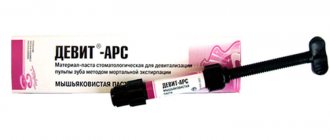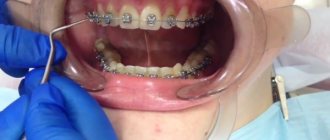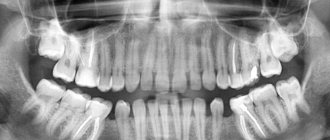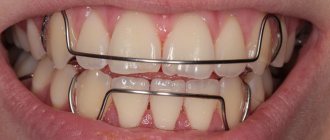Installing a temporary filling is a filling method in which treatment cannot be carried out in one visit to the dentist. The period for which a temporary filling is installed is variable and can range from a day to several years. How long to walk with such a filling depends on the reason for its installation, the material and the reaction of the oral cavity to the foreign compound.
Only the attending physician can predict how long you can walk with a temporary filling, subject to an accurate history, diagnosis and subsequent treatment.
In what cases is a temporary filling placed?
A temporary filling is installed in several cases. If complicated pulpitis or caries for some reason has to be treated conservatively. Then the specialist is obliged to clean the damaged area from inflammation or darkening and treat the tubules.
The drug is injected into the resulting void (previously cleaned), and then sealed with a temporary filling, with which you need to walk, protecting the treated cavity from pathogenic microflora.
To diagnose damage to nerve endings. In such a situation, the damaged area is temporarily sealed to prevent infection and minimize the risk of pulpitis.
To remove the dental nerve. This is used for severe pulpitis. The doctor first needs to reduce the pain that torments the patient and make the nerve insensitive. A couple of days before the removal procedure, arsenic or a more popular and safe drug is injected into the lesion (depending on the pharmacological action of the drug, the specialist determines how long to walk with it).
On the day of surgery, the temporary filling is removed and treatment is completed by removing the nerve and installing a permanent filling.
If there is a need for prosthetics. While the permanent prosthesis is under development, the patient needs to walk with a temporary filling. This is necessary in order to avoid infection of the problem area during this period.
Recommendations from experts
Sports medicine specialist Harry O'Donovan believes that "exercise is an essential part of a healthy lifestyle, and brisk walking is an ideal way to get yourself moving."
To achieve optimal physical activity, men should walk 95 to 102 steps once a day for half an hour, women - 91-115 steps.
Scientists advise gradually increasing the rhythm and starting with 1000 steps in 10 minutes, then gradually reaching 3000 steps in half an hour.
Materials for temporary fillings, and for how long they are installed
The following compositions are used in modern dental clinics:
- Oil dentin
The filling base is zinc oxide. The filling substance hardens for 2 hours, but then remains slightly mobile and wears off (under mechanical influence), without creating discomfort in the bite area. The filling is bright white, which is very different from the natural color of the enamel.
Oil dentin is inexpensive and fragile, making it unsuitable for long-term wear. Usually lasts up to a week.
- IRM material
It is a zinc oxide eugenol cementitious substance that is stronger than oil dentin. Compared to the previous option, IRM hardens faster (in a matter of minutes). After hardening, it requires grinding and, if necessary, adjustment to the bite.
The color is unnatural, lighter than enamel. The high strength of IRM determines its increased duration of stay at the site of damage (you can walk with it for several months or even years).
- Clips
The clip has very low strength. It cannot seal the cavity formed in the tissues hermetically, and is not able to prevent bacteria from entering it. Therefore, it cannot be used as an independent material; it must first be sealed with a base substance. The clips are very short-lived, and you can walk with them from a day to a month.
- Glass ionomer compounds
This is a very durable filling compound, which was previously used for permanent fillings. Glass ionomer substances have an anti-caries effect, however, they are more expensive in comparison with the compounds described above.
To treat teeth using this method, drilling will be required. But then, when installing a long-term filling, it can be avoided, since part of the temporary connection will serve as an insulating gasket (which will reduce the risk of pulp trauma).
A nice bonus of glass ionomers is the color, which often completely matches the color of the enamel. It is impossible to say for sure how long you can walk with such a connection; the wearing time is determined by a specialist.
- Composite materials
Composite compounds are considered the best in dentistry today and are widely used for long-term fillings. The advantages of these fillings are high strength and matching the color of the enamel . Composite compounds are used for temporary fillings when a high-strength base is required due to fragile tissue or the presence of a large affected area.
In addition, they are used when aesthetic appearance is important, especially if the material will be on public display when the patient smiles. The attending physician will tell you how long it will take to replace the established substance with a long-term alternative, since composite compounds do not fall out on their own and can last a long time.
Life time
The service life of a temporary filling varies from 3-4 days to 2-3 weeks. The exact timing depends on the specific dental disease and the drugs used in treatment.
Here's how much a temporary filling can cost in different situations:
- when using arsenic paste to kill a diseased nerve - no more than 2-3 days (usually 24-28 hours), when using other means (for example, paraform paste) for the same purposes - 5-10 days;
- when using antibiotics and antiseptics in the treatment of deep caries or pulpitis - from 3-4 days to 2-3 weeks;
- in particularly complex diagnostic cases – up to 3 and even 6 months.
If you can’t get to the doctor on time, be sure to notify him in advance. In this case, if possible, he will try to place the most durable reflective filling that can be safely worn for several months.
How to care for a filling
How long you can walk with a temporary filling largely depends on caring for the sealed area and the oral cavity as a whole. To ensure that nothing happens to the installed filling prematurely, you should follow some recommendations. To perform daily oral hygiene, use a toothbrush made of soft material. Try to minimize the load on the injury site while eating.
Avoid mechanical impact on the place where the filling is installed: avoid hard sweets, toffees and chewing gum, so as not to disrupt the adhesion (attachment) of the filling substance. In addition, you should not eat too cold or hot dishes, or change the temperature of food too sharply while eating - this puts a lot of stress on the tooth enamel (how long a temporary filling will last largely depends on this coating).
Avoid products with increased and persistent pigmentation (beets in any form, tea, coffee, dark grape varieties and wines made from them), as the filling may change color.
If discomfort or inflammation occurs in the gums close to the filling site, you should consult your doctor. If this is not possible, and the pain needs to be relieved with something, you can use decoctions of chamomile or calendula flowers for this purpose.
In case of obvious inflammation, it is recommended to use solutions with an antiseptic effect: they help tissues recover and minimize the risk of aggravating the problem by pathogenic microorganisms. If cheaper substances are used for temporary filling, then after a visit to the dentist you should refrain from eating for 2 hours: the filling substance should completely harden - this will reduce the likelihood of deformation or destruction of the filling.
If an analgesic is needed when complications occur, you should consult a specialist. Under no circumstances should you take acetylsalicylic acid - it can harm the digestive system.
Complications with temporary fillings
Complications may occur due to filling in some cases:
- the specialist installing the filling made a mistake and touched the pulp;
- the body perceived the filling material as foreign and began an autoimmune reaction, rejecting the filling;
- the rules for caring for the filling were violated;
- microorganisms still got into the damaged tooth.
How can you suspect a problem yourself?
If the filling site or the gums around it hurt. This can happen in case of an allergy to the installed filling, due to the formation of a cyst, the development of periodontitis or pulpitis. If the filling substance crumbles or falls out. In this case, you can’t waste a minute - you shouldn’t delay visiting the dentist, because the risk of infection of the cavity in the damaged tooth increases.
If you have an unpleasant medicinal taste or smell in your mouth. This can happen if the temporary filling was caused by the presence of medication in the cleaned cavity. This phenomenon may indicate a leak in the seal.
If the filling has changed color, swelling of the tissues located in the immediate vicinity of the damaged tooth appears, and bad breath is felt, these are signs of complications. To understand the essence of the problem, a specialist must remove the filling and examine the tooth.
To avoid problems with a temporary filling, it is worth following the deadlines set by the doctor: each patient’s body is individual and requires a special approach. It is necessary to follow oral hygiene recommendations and not self-medicate. If you experience any discomfort in the sealed area, do not hesitate to visit a doctor. Remember that timely treatment of dental diseases is the key to your health and comfortable life.
Why you need to walk
Let's look at a few good reasons to be convincing:
- Walking is an aerobic form of physical activity, in other words, the same sport as running, swimming, fitness, etc.
- Walking helps strengthen muscle tissue and improves the functioning of the cardiovascular system.
- When walking, the level of stress resistance increases, mood improves, and sleep normalizes.
- While walking, the risk of injury is extremely low.
- Walking helps burn calories.
- Walking is accessible and easy.
- Suitable for people of all ages and has virtually no contraindications.
- Walking does not require special training or equipment.
- The risk of developing a number of serious diseases, such as diabetes, atherosclerosis, glaucoma, osteoporosis, etc., is reduced.











